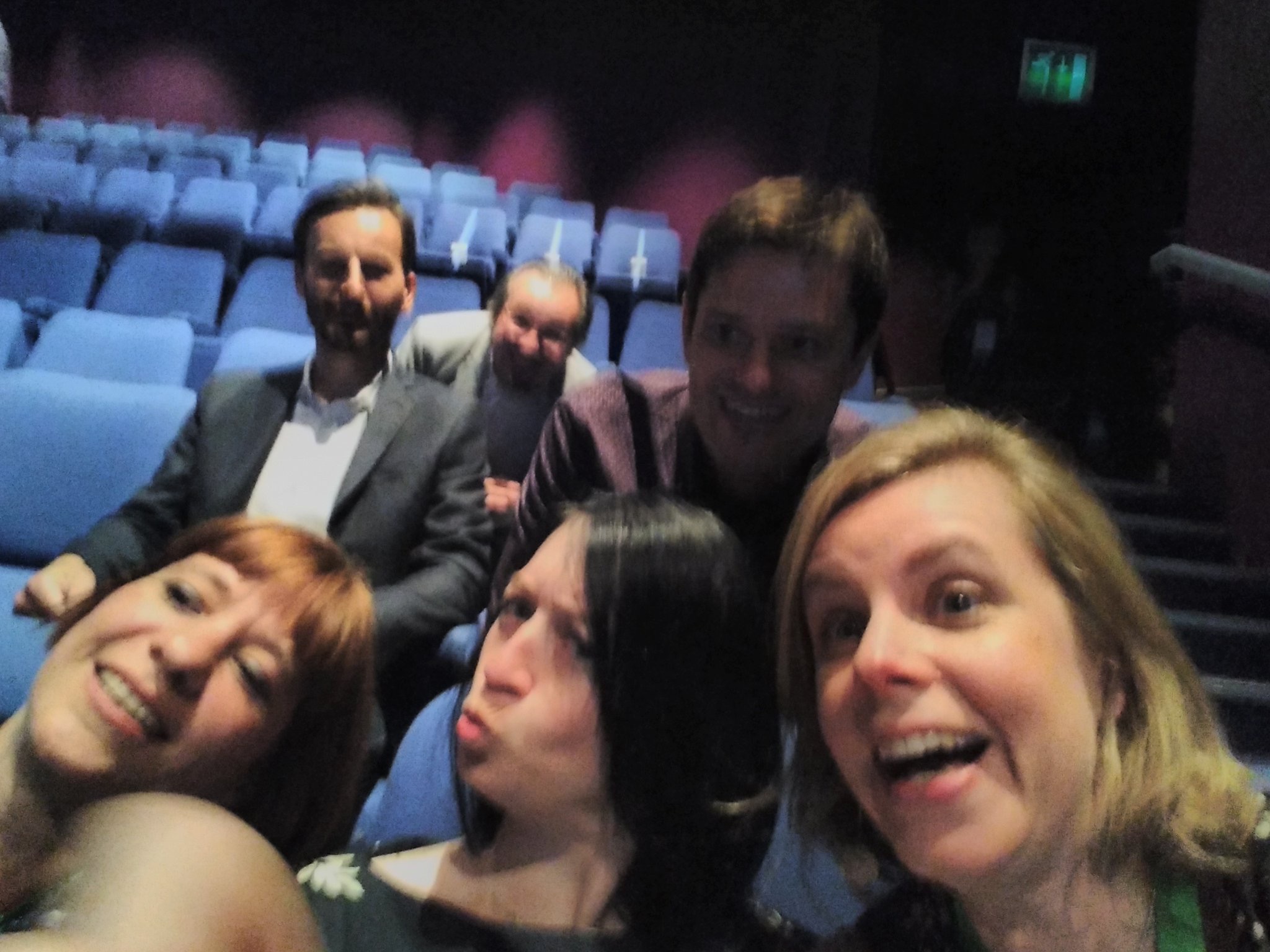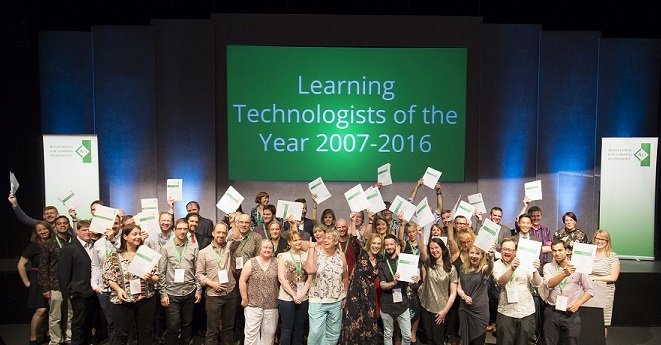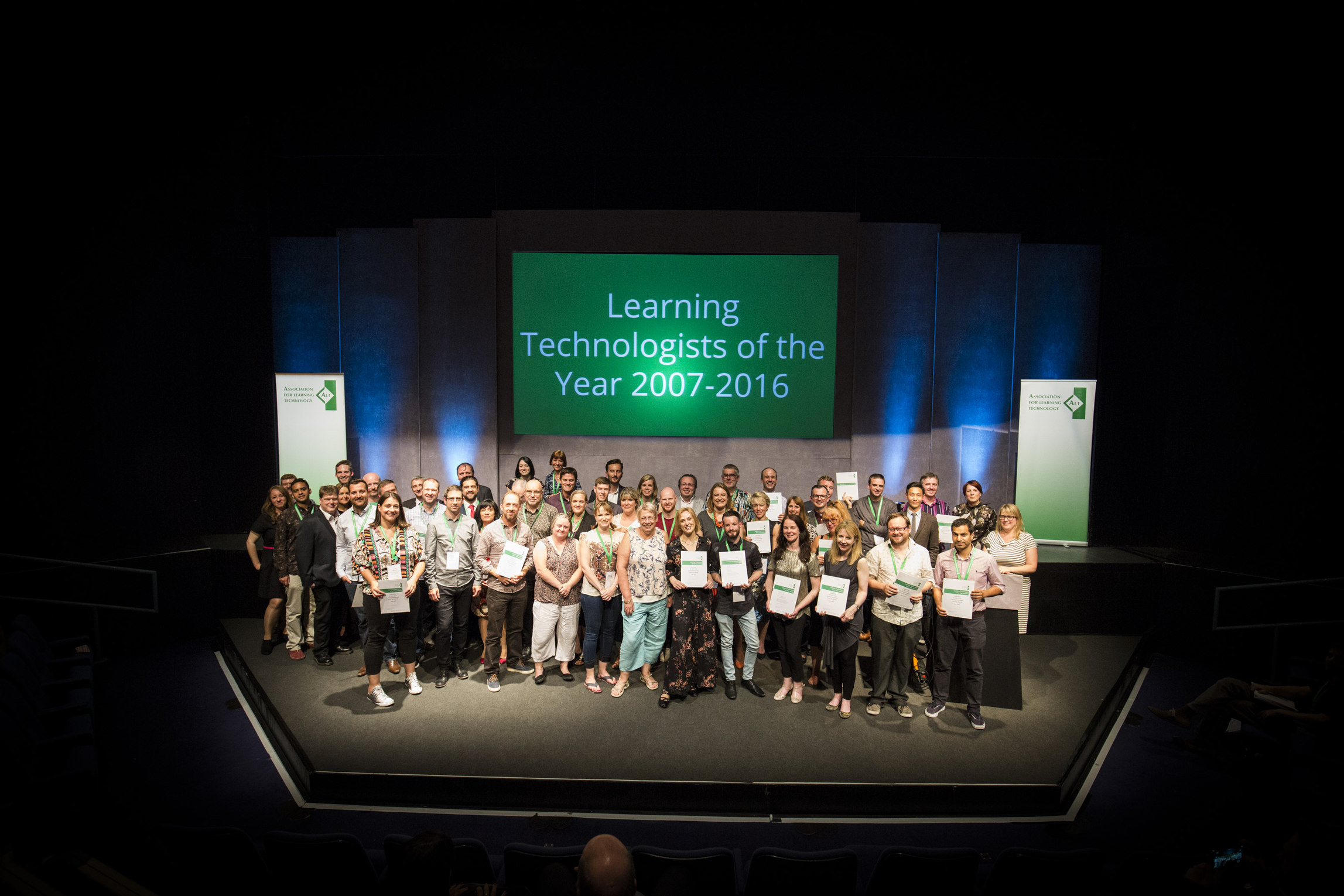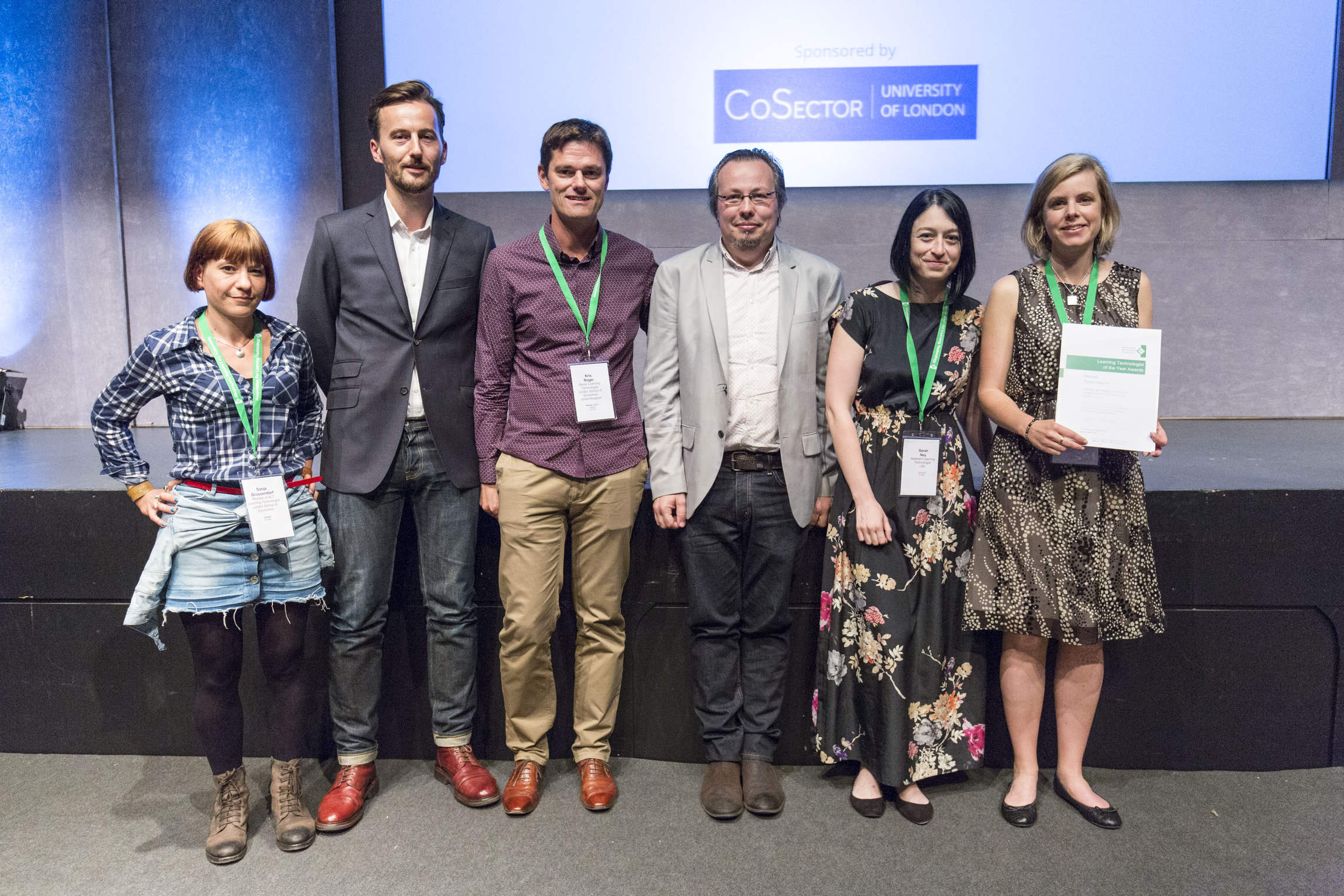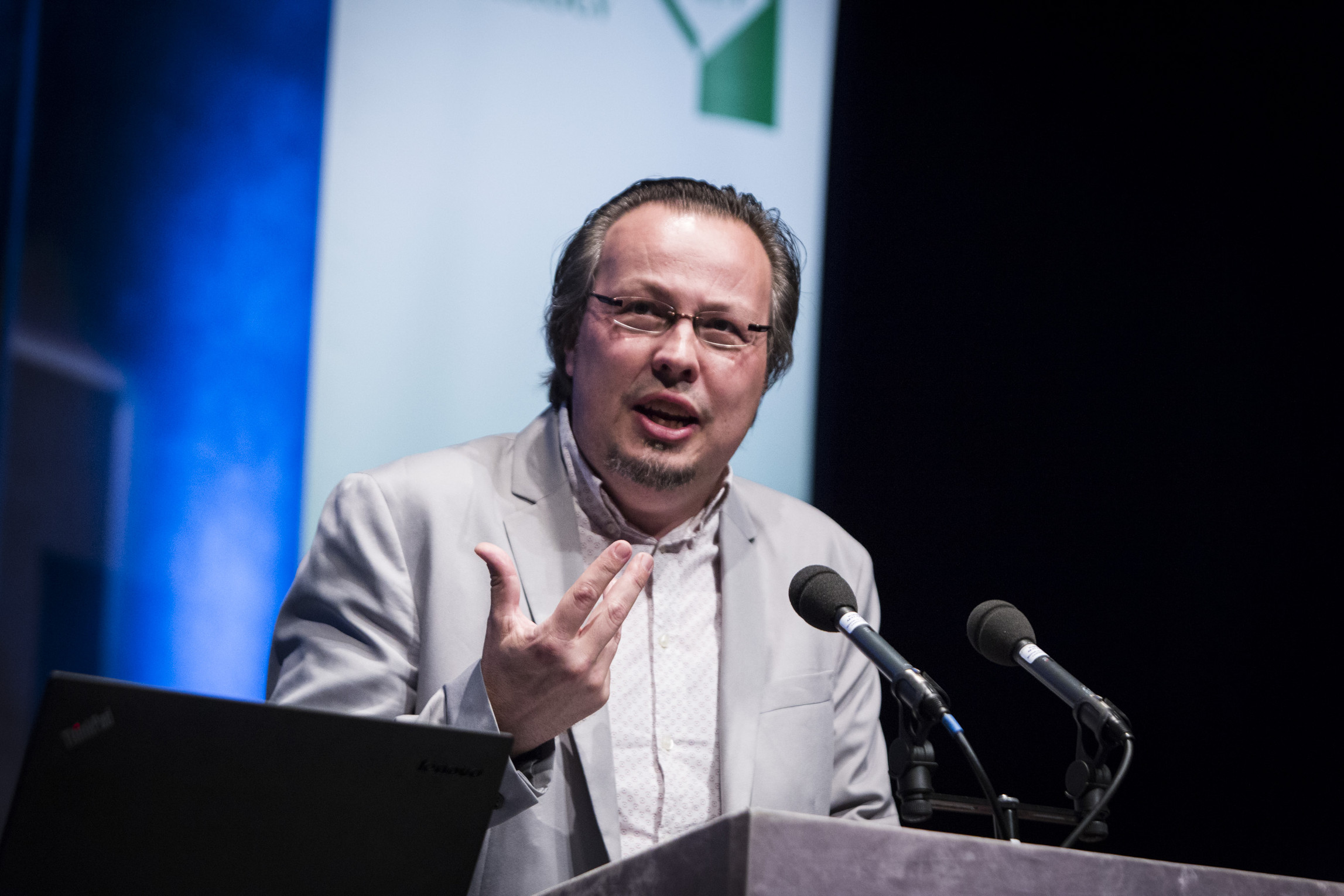A new series of updates about emerging trends in learning technology and digital literacy
Playful and Creative Learning in HE
Next Tuesday LTI will be hosting a presentation by Chrissi Nerantzi (Principal Lecturer in Academic CPD, expert in creative, innovative learning, teaching and assessment from Manchester Metropolitan University) on Playful and Creative Learning. A good opportunity to reflect on what playfulness and creativity mean in an educational context and explore ways in which we can promote it in our practice.
Definition: What is playful learning?
In a blog post by JISC titled “Learning to play, playing to learn: the rise of playful learning in higher education“, Chrissi gives an explanation of what playful leraning means to her:
“Playful learning is using play activities to immerse ourselves and learn, either on our own or with others in a space we feel safe. In playful learning it’s ok to make mistakes when experimenting with new ideas, when challenging ourselves and others and doing things we normally wouldn’t do – which can lead us to surprising discoveries.
Playful learning can happen anywhere.”
Play and Its Connection to Creativity
The “Creativity for Learning in Higher Education” open course, based on the Manchester Metropolitan University’s PgCert and MA in Higher Education in which Chrissi is involved, offers colleagues with an interest in creative teaching and learning to explore three areas that foster more creativity in their practice and their students’ learning experience. One of which is play and games.
As Resnick (2017) puts it,
“Creativity doesn’t come from laughter and fun: It comes from experimenting, taking risks, and testing the boundaries.”
When it comes to experimenting, games are a very powerful learning tool. Games are by definition a space where the rule of the real world do not apply, thus providing a safe space to take risks and experiment with various choices, strategies and outcomes.
Moseley and Whitton (2015) define games as“a safe space in which participants have freedom to make mistakes, learn from failure, play with fantasy and identity, have control over decisions and outcomes”
Interested in finding out more?
Check out Chrissi’s various projects around playful and creative learning:
- #creativeHE Google + community site
- Creativity for Learning in Higher Education open course from MMU
At LSE
- Head to our dedicated web pages to find out more about Game-Based Learning and related projects run and supported at the LSE.
- Apply for our IGNITE and SPARK grants to support your game-based learning project for your own course or at programme and departmental level.
- Join Chrissi’s session on Tuesday 6th February or LTI’s practical session on Designing Games for Learning on 26th February
References
Resnick, M. (2017). Lifelong Kindergarten: Cultivating Creativity through Projects, Passions, Peers, and Play. MIT Press.
Moseley, A. and Whitton, N. (2015). Using Games to Enhance the Student Experience. Higher Education Academy
An evaluation of LSE’s new informal learning spaces
In the 2016-2017 academic year, staff at LTI undertook an evaluation of the use of new LSE informal learning spaces. The findings and lessons learnt can be found in our final report. Here are the highlights.
Background
As part of a School-wide objective to provide students with more informal learning spaces across campus, “forgotten” spaces were redeveloped and opened for the 2016-17 academic year. Staff at LTI led the design of 6 spaces – one at each landing of Clement House’s back stairwell- along with Estates, the Teaching and Learning Centre and AV services.
While each space was designed to fulfil a specific function, such as collaborative work or quiet study, they were also intended to be flexible so that students could own and shape them.
This work was also an opportunity for LTI to experiment with new configurations and technology to apply a variety of modular spaces for LSE’s future buildings. LTI’s report investigates the effective use made by students of the six spaces, and whether they match the design intentions. It also provided a context to understand how they fit into the overall experience of students with informal learning spaces at the School.
 Click the picture for a description of the spaces
Click the picture for a description of the spaces
Findings
In spite of the fact that the effective use of the spaces did not always match the original design intentions, the spaces were welcomed by both students and staff and saw high levels of occupancy.
As far as use is concerned, students seemed to favour individual use of the spaces, even on those floors fitted with collaborative furniture. This was found to align with the most common approach to teaching and learning adopted at the School and also reflected in assessment, namely quiet study and individual working. It would be interesting to reassess the use of those and similar spaces once other modes of teaching and assessment are adopted as a result of the School-wide initiative to diversify assessment from next year.
With regards to the spaces themselves. students appreciated the calm and relaxed feel to the spaces and the range of equipment available to them. Areas for improvement include noise levels (especially between classes) and a lack of work space (such as tables or chairs).
Report
More information about the spaces, findings and our analysis can be found in the full report: An Evaluation of Clement House Informal Learning Spaces.
LTI is currently working on the redevelopment of other informal spaces, as well as three rooms in various areas of the campus (more details to follow soon)
Findings from this evaluation and our previous new teaching spaces evaluation will inform the design of these spaces and the future ones.
We would love to hear your feedback, please use the comments below or email LTI to share your thoughts!
Blogging as a Method of Assessment
The past couple of years an increasing number of LSE academics started integrating blogging in their courses. This took various forms, from using the blog feature on Moodle as an added activity to creating individual blogs for students as part of a course summative assessment. One thing that all these projects shared is the rationale for using blogs in an educational context: encouraging student engagement, making learning more student-centred and diversifying assessment with the view to making it more relevant to the course and developing students’ transferable skills.
A good example of such initiative is Anthropology’s Dr Walker AN300 student blogs project. Dr Walker applied for a SPARK Grant last year in order to support his project to “develop the use of student blogs as one component of the summative assessment for AN300 Advanced Theory of Social Anthropology”.
Below is a summary of the project and its outcomes, with quotes form Dr Walker’s application and project report, whose full version can be found on his project page.
What was done
AN300 is an intensive reading course focusing on full-length books rather than journal articles. There are three ‘cycles’ per term, each devoted to a different book […] Each student was required to produce his/her own blog. […]Students were expected to make one post each week for the first two weeks of each book cycle (12 posts for the course overall). Every third week was dedicated to commenting on the posts of others. The final mark consisted of the average of each student’s best eight posts.[…]The posts were assessed weekly by a GTA who was also in charge of providing feedback.
Students also attended a session on writing for blog run by LTI at the beginning of their course.
Rationale
Developing students’ academic and life skills
The aim of this project was to encourage students to develop their own original ideas and critical responses to key texts in social anthropology, as well as to cultivate their capacity to respond thoughtfully and diplomatically to the ideas of others. Making regular blog entries was also meant to encourage students to keep abreast of the required readings for each week, partly in order to positively impact the overall quality of class discussions. The project was also intended to cultivate students’ digital literacy, providing them with training in an increasingly widespread form of disseminating information.
Diversifying assessment
[The course format] is sometimes described as an advanced reading group. This makes it ill suited to exams as a mode of assessment. The blogs, by contrast, allowed students to develop their own ideas about the books they were reading as they went along.
Students appreciated the opportunity the blogs provided […] to work in a medium other than an essay or exam.
Evaluation
In general, the trial can be considered a success. […] The posts that resulted were often highly original and creative. Students appreciated the opportunity the blogs provided to be more experimental with their ideas and arguments, and less formal in their writing. […] Having to write a post prior to class gave students an opportunity to critically reflect on the readings, and to bring to the class ideas they had developed in their blogs
Lessons learnt
Clarity was identified as a key area for improvement in the project, as its absence seems to have caused some frustration among students. The main aspects that were identified as critical were clear guidance and expectations, grading criteria and feedback on the blog posts.
It is also worth noting that it was the first year blogs were tried in the department. The fact that students were not (yet) familiar with this type of activity made it even more important to provide them with extra guidance.
Outcomes
You can find a detailed evaluation report on the project’s dedicated web pages. The report includes guidance given to students at the start of term along with marking criteria, and examples of student posts and comments.
If you are interested in using blogging as a teaching tool, check out our and TLC’s resources or get in touch to discuss your ideas.
This project was funded by LTI’s SPARK Grant. More info on similar teaching innovation projects and how to apply on our website.
Using Powerpoint to create engaging simulations
Last academic year, two PhD students teaching in the Department of International Relations embarked on a journey to make their course more engaging to students. They applied for an LTI SPARK! Grant to support the development of Powerpoint-based simulation games.
Here are the highlights of the project following its completion and evaluation. Quotes are from the two recipients of the grant, Gustav Meibauer and Andreas Aagaard Nohr.
Related outcomes and resources on our website
The rationale
Issues addressed
Currently available IR simulations for teaching purposes are often high-cost/high-tech and especially time-intensive: even if they do not require custom-made software packages with difficult interfaces and expensive licensing fees, they are almost without exception targeted at course-long or at least day-long activities that demand extensive preparation of both teachers and students, with book-length manuals, intricate rules, integrated assessment tools, and specific secondary literature. This is irrelevant for most of the undergraduate teaching practice, especially in introductory courses that often treat specific concepts only once in a 50-minutes class. But this should not mean that undergraduate students simply never get the chance to profit from interactive gaming and simulations.
Why simulations? The pedagogy behind the technology
The project is based in the pedagogy of experiential learning, student ownership and self-directed learning, and the use of gaming activities and simulations in the classroom.
Simulations and interactive gaming solutions have long been known to enhance understanding both of specific empirical examples as well as, more importantly, theoretical linkages because they make students experience, rather than only hear about, factors and variables involved in such different topics as foreign policy decision-making, diplomacy, great power dynamics or identity formation.
Students do not simply passively receive the PowerPoint (as in a standard presentation), but play it, change its outcome (within given options), determine what the next slide will show, and are thus actively involved in what they learn. This is thought to encourage deeper learning.
It is not the outcome of the simulation that matters, but the process of its coming-about. Just as in real-world foreign policy or diplomacy, there is not necessarily a correct path to take or a right decision to find – instead, by playing the simulation, students engage in discussion and compromise, take into account a multitude of different factors, realize own mistakes, and get a feeling for the complexity of decision-making in multiple settings.
Why Powerpoint?
There is no need to change the course design, overhaul the entire teaching approach, or experiment wildly outside what is currently known and available. Instead, our project aims at diversifying teaching where possible to integrate student-centered, activity-based teaching and learning. It does so by bringing out the true potential of already available teacher skills and learning technologies.
We do this by employing PowerPoint, specifically in-built features such as hyperlinks, interactive pathways, or audio or video integration that can be used interactively rather than passively.
Implementation
Integration into the course
By necessity, simulations do not stand alone: they are accompanied by a set of theoretical structures and debates in which students talk and theorize about their experiences during the gaming activity
Each of our simulation classes consisted of an introductory stage of about 5 minutes, a simulation stage with multiple discussion periods interspersed (moderated variously by the class teacher or by the students themselves, depending on class dynamics) of about 20-30 minutes, and a discussion stage to tease out theoretical insights of about 20-30 minutes.
Take Aways
“Andreas and Gustav came up with a formula that gave students ownership of their own decisions and helped them to apply their knowledge to difficult real world dilemmas. Students were able to experience the consequences of both the cautious and risk taking approach and the many nuances and customs that apply to foreign policy decisions.”
Sarah Leach, Senior Learning Technologist on the project
Students experience
Overall, results indicate a positive impact on student learning: students on average perceived simulations were enjoyable, allowed for stimulating discussion in the classroom and an experience of expertise and immersion into the topic of the class.
Not only did the simulations add an important additional method to diversify the learning experience and complement more “traditional” instruction styles, they also led to greater overall participation rates in class (compared to more conventional class types, as assessed by teachers, observers, and the students themselves), allowed students to bring in own previous experience and learn from their peers, and try out learned theoretical concepts in class.
They gave students a language to talk about new and often highly abstract concepts, and allowed for smooth and often in-depth reflection and discussion. The simulations also proved entertaining and supported positive group dynamics in class, such as self-moderated discussion and quick exchanges between students without teacher interference.
The teacher’s views
They allowed us as teachers to transition more easily towards roles of moderator and facilitator, as students interact with the simulation and with each other without input or instruction from the teacher.
Students worry that the simulations somehow divert from the “actual” material they are supposed to learn from the course, which means additional effort has to be put into developing desired learning outcomes and appropriate theoretical teaching materials.
“Andreas and Gustav have demonstrated that engaging students with technology doesn’t have to be daunting or cutting edge, a simple tweak can dramatically change the learning experience for students. To make this step even easier, they have written a ‘how to’ guide for any teachers who want to create simulations for small class teaching. The guide covers every aspect from defining the learning objectives and creating the slides through to teaching plans and evaluation. It’s a great resource.”
Sarah Leach
If you are interested in using technology to support teaching, learning and assessment like Andreas and Gustav, then please get in touch with LTI to discuss your ideas. Take a look at LTI’s SPARK! Grants for more information.
Playful learning
In February I was lucky enough to attend the ‘RemixPlay’ event at Coventry University. Hosted in the amazing ‘Disruptive Media Lab’ the day featured some really interesting speakers (Ian Livingstone (CBE), Bernie DeKoven, Professor Nicola Whitton and Dr Sebastian Deterding). There are already some great write-ups about the event which I won’t replicate here, instead see the blog post by Daryl Peel from University of Southampton and The Flying Raccon’s write up of Remix Play.
For me the conference highlighted the positive aspects of play and I left thinking that we should do more to invite ‘Playfulness’ in Higher Education. Creating a playful environment/community encourages exploration, collaboration, creativity and gives people agency to try things out and have the freedom to fail, all key conditions for learning. There is an abundance of literature on learning through play and it’s importance see ‘Play, Playfulness, Creativity and Innovation’ by Patrick Bateson, Bernard Suits book ‘The Grasshopper – Games, life and Utopia’ and the ‘How We Get To Next’ reading list on the Power of Play especially the video’s at the end.
Some nice examples of a playful environment given by speakers at the event:
http://www.musicalswings.com/about/
http://www.thefuntheory.com/piano-staircase
As Jordan Shapiro et. al. note in Mind/Shift Guide to Digital Games + Learning (Joan Ganz Cooney Center/KQED, 2014)
“Play is exploration. It involves imagination. It means investigating the world of the game and feeling the frustration, flow, and excitement that goes along with playing it.”
Games designed to enable learning are becoming more popular in Higher Education. Games are a more structured version of ‘play’ and allow players to problem-solve and often involve collaboration and peer learning. Although they often involve rules and winners, games give autonomy to the players and provide a safe environment to fail and to try and test things out. They are often about making decisions and then seeing the consequences and receiving feedback on your actions. As Professor Nicola Whitton stressed, students need low-impact opportunities to experience failure (micro failures); it’s how they get feedback, learn and improve.
Games at LSE
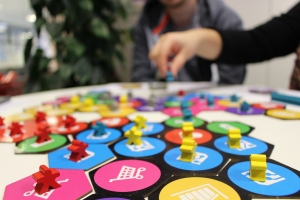 As part of an LTI grant, I have been working with colleagues in LTI on the LSE100 course to create a board game which was played in classes this term. One of the key difficulties when designing the game was to get the balance between play and content right. Too much content, and it’s not a game anymore, it’s a lecture and it’s not fun. Too much concentration on the game, and the learning outcomes are not as obvious and it’s harder for students to make the links between the concepts that you are trying to illustrate. We are now evaluating the game collecting and collating feedback from students and staff, so look out for updates on this shortly.
As part of an LTI grant, I have been working with colleagues in LTI on the LSE100 course to create a board game which was played in classes this term. One of the key difficulties when designing the game was to get the balance between play and content right. Too much content, and it’s not a game anymore, it’s a lecture and it’s not fun. Too much concentration on the game, and the learning outcomes are not as obvious and it’s harder for students to make the links between the concepts that you are trying to illustrate. We are now evaluating the game collecting and collating feedback from students and staff, so look out for updates on this shortly.
LTI has awarded several grants to projects involving games, including ‘Capture the Market’ board game mentioned above and an Ethnographic point and click video game, more info and resources can be found on our website.
Game workshop
If you are interested in exploring the use of games in education, we are running a workshop on ‘Designing quick and effective games for learning’ with Alex Moseley on Wednesday 26 April. Alex has been involved with games in education for 8 years and has lots of experience with designing games for learning. You can read an interview with Alex on this blog and you can book a place on the workshop on Eventbrite.
Spark grants
Applications for LTI spark grants are now open http://lti.lse.ac.uk/lti-grants/ with the deadline of Friday 5 May. If you are interested in finding out more, check out the LTI website and contact us to discuss your idea.
NMC Horizon Report 2017: Key trends and challenges of technology in the global HE Sector
The 2017 (Higher Education) horizon report was released a week ago by the New Media Consortium (nmc). It reflects on what the global HE sector is doing with and about (educational) technologies, how it deals with key trends and how it faces critical challenges. Most interestingly, it reflects on these trends and challenges and forecasts which technologies will be taken up by the sector in the short, medium and long term.
It is one report to which it really pays to pay attention, and is short enough to be read in a lunch hour. For a shorter read you might look at their summary 10 talking points. Or you can stay with this blog post and have a look at my summary of this year’s trends, challenges and technologies below. I explain some of the terminology used in my summary of the 2015 Horizon report. Technology concepts are explained or linked to below.
Trends, challenges, technologies:
Trends
Key trends in the sector drive technology adoption, and in the short term these are: Blended Learning Designs and Collaborative Learning.
In the mid-term, the sector is driven by Growing focus on measuring learning and Redesigning Learning Spaces.
In the long term, the sector is driven by Advancing Cultures of Innovation and Deeper Learning Approaches.
Challenges
The sector faces plenty challenges, some that we know, understand and are able to meet ‘easily‘, because we have been facing them for a while now: Improving Digital Literacy and Integrating Formal and Informal Learning.
The Achievement Gap, which “reflects a disparity in the enrollment and academic performance between student groups, defined by socioeconomic status, race, ethnicity, or gender”, and its ‘complement’ challenge to Advance Digital Equity present more of a headache and are a difficult demand on the sector as a whole.
The report suggests as wicked challenges, those that are “complex to even define, much less address”: Managing Knowledge Obsolescence, and Rethinking the Roles of Educators.
The former refers to the rapid rate of technologies cropping up and (possibly) vanishing again, while the latter refers to how teachers are to cope with that and the shift towards proper student-centred learning. The latter was mentioned as a key trend for the first time in the 2010 report and continued to appear until 2013, after which it was dropped, presumably as something that had happened. That this year it is highlighted as a wicked challenge suggests that a) it has become a much more pressing issue and b) educators continue to struggle with adapting to the changes in the Higher Education sector, and/ or the 21st Century as such.
Technologies take-up projection:
In about one year: Adaptive Learning Technologies (Think of it as mimicking the luxury of personal tutoring which reacts to individual students’ progress through their learning as it happens); Mobile Learning (harnessing the awesome computing power that almost all of us have in our phones these days).
In about 2 to 3 years: The Internet of Things (your fridge tells your phone to tell you to buy milk; moodle tells your students’ Applewatch to remind them to eat porridge and finish their dissertation); Next-Generation LMS (Moodle, but a bit slicker? So Moodle with a make-over…).
In about 4 to 5 years: Artificial Intelligence (intuitive computer tutors; HAL); Natural User Interfaces (“speech recognition, touchscreen interfaces, gesture recognition, eye-tracking, haptics, and brain computer interface”).
How good at predicting are Horizon reports? In a follow-up post I will offer an overview of ten years of Horizon report predictions.
‘What is the place of technology in delivering an outstanding student experience?’
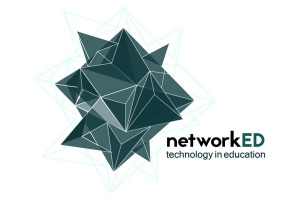 LTI are pleased to host Professor Robert Allison Vice-Chancellor & President of Loughborough University for our first NetworkED of 2017. Professor Allison will be discussing the role that technology and innovation have played in the success of Loughborough in becoming one of the leading universities in the UK, and the challenges he sees in the ‘uncertain futures’ for HE over the next 5 years.
LTI are pleased to host Professor Robert Allison Vice-Chancellor & President of Loughborough University for our first NetworkED of 2017. Professor Allison will be discussing the role that technology and innovation have played in the success of Loughborough in becoming one of the leading universities in the UK, and the challenges he sees in the ‘uncertain futures’ for HE over the next 5 years.
The talk will be held on Wednesday March 1st at 2.30pm and will be held in KSW G.01. Book your free ticket for this event here http://bit.ly/2lgAlSy
Ahead of his NetworkED seminar next week we had a quick Q&A with Professor Allison.
Q. You have been the Vice-Chancellor and President of Loughborough University since September 2012, how has Loughborough responded to the significant changes that have occurred in Higher Education during that time?
Loughborough has responded by maintaining a degree of agility, allowing us to respond promptly to the expectations of our students and through working in partnership with them as stakeholders in the University, not as customers or consumers.
Q. Loughborough University has been successful in numerous university rankings during this time including being awarded 1st for student experience in the TES 2016 survey, what are the key principles at the heart of that success?
The most important factor in our success has been seeing our students as co-creators of their education and wider student experience and, through this, giving them a tangible link to the success and future of the University.
Q. What role have technology and innovation played in the enhancing the student learning and teaching experience at Loughborough?
In some areas the role of technology has been significant, in others not relevant at all.
Q. The theme of the 2017 NetworkED seminars is ‘Uncertain Futures’, what do you feel will be the most potentially disruptive (or transformative) issue facing Higher Education institutions in the next 5 years?
Disruptive: competition.
Transformative: marketisation.
For those that cannot attend the seminar will be recorded and added to the LTI Youtube channel.
You may also be interested in attending our upcoming NetworkED seminars:
Liz Sprout from Google education on Wednesday 10th May
Andy Moss from Pearson Education on Wednesday 14th June.
Mapping learning and teaching
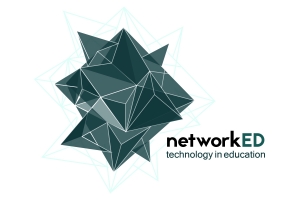 Our next NetworkED seminar is with James Clay,
Our next NetworkED seminar is with James Clay,
on 23 November 14:30-15:30
James is a Jisc project manager and was previously the Group Director of IT and Learning Technologies at Activate Learning which incorporates City of Oxford College, Banbury & Bicester College and Reading College, where he was responsible for ILT, IT Services, Business Systems and Learning Resources.
We asked James to tell us more about his upcoming seminar on Mapping the teaching and learning
“Mapping is an useful exercise in uncertain times to think about practice and though any such map may not be accurate or complete, it does allow you to consider and think about actions and training required to change behaviours or how spaces and tools are used.
Over the last few years we have seen considerable use made of mapping the use of social networking tools using the concept of Visitors and Residen ts. This was developed by Dave White, Donna Lanclos and Lawrie Phipps into an exercise that could be used to think about a current snapshot of their practice.
ts. This was developed by Dave White, Donna Lanclos and Lawrie Phipps into an exercise that could be used to think about a current snapshot of their practice.
The mapping exercise makes you consider how you are using various tools and what needs to happen to change that map, how do you become more resident when using a tool such as Twitter for example. Or how do you start using a tool which is currently not on your map, such as a professional blog?
The key thing I like to remind people about when using the mapping that this is a continuum and not a distinction between two groups. Your personal Visitors and Residents map is not, and should not be a static thing. The mapping changes as new tools are introduced, old ones retire and your role and behaviours change. The Visitor and Resident mapping exercise in the main covers digital communication, collaboration and participation.
This session discovers if we could we use a similar concept to map teaching practice, curriculum design and learner practices? Sometimes it’s not just about knowing where you are, and where you need to be, but how you get there”.
References
Clay, James (2016) Mapping the learning and teaching
http://elearningstuff.net/2016/01/14/mapping-the-learning-and-teaching/
Visitors and Residents: A new typology for online engagement by David S. White and Alison Le Cornu. First Monday, Volume 16, Number 9 – 5 September 2011 http://firstmonday.org/ojs/index.php/fm/article/view/3171/3049
White, David (2016) Visitors & Residents – navigate the mapping
http://daveowhite.com/vandrworkshops/
Lanclos, Donna (2016) Ta Dah! The Hitchhiker’s Guide to Doing a Visitors and Residents Workshop
http://www.donnalanclos.com/?p=570
Phipps, Lawrie (2016) Mapping for Change
http://lawriephipps.co.uk/?p=8305
Mahara, Blogging and Peer Review
Edgar Whitley from the department of Management tells us about using Mahara as a tool for blogging and peer assessment and its benefits to teaching, learning and assessment.
LTI in the spotlight
Last week staff from LTI attended the Association for Learning Technology’s annual conference (ALT-C 2016). It was an eventful three days at the University of Warwick for the team, with five of us presenting a total of 4 papers and one keynote. And oh, we also won the Learning Technologist of the Year Awards!
Learning experiences and virtual learning environments: It’s all about design!
A design for learning; Learning Experiences for the Post-Digital World – Peter Bryant
In the first part of his presentation, Peter described his new approach to teaching and learning whereby seven learning experiences (found, making, identity, play, discontinuity, authenticity and community) can “shape, influence and enhance the opportunities for students to learn, to share learning and to teach others in a post-digital world”. Participants then discussed how existing learning technology tools could be used to create such learning experiences.
You can find a summary, reflections and slides from Peter’s presentation on his blog
Good post: we’re not using technology to its full potential. We’re using it to do old things in new ways. https://t.co/PO4vgXe831
— Tony Burke (@TonyBurke1) September 9, 2016
Innovating from the Outside In: a Creative Hub to Change eLearning Practice- Sonja Grussendorf
Sonja introduced the audience to LTI’s “creative hub”, a project bringing together film makers, artists and designers, and how it is being used to design a VLE that can “accentuate communication between participants; support independent learning, collaboration and student creativity; facilitate peer learning and peer assessment and deliver ongoing, two-way feedback opportunities.”
very well thought out and presented session from @authenticdasein #altc
— Sheila MacNeill (@sheilmcn) September 8, 2016
Physical teaching and learning spaces
Learning Spaces: Roles and Responsibilities of the Learning Technologist – Kris Roger and Sarah Ney
While Sonja was presenting on virtual spaces, Kris and myself discussed physical teaching and learning spaces. More specifically, we reflected on a recent project to develop new active learning spaces at the LSE that made us wonder about what our roles and responsibilities as learning technologists were in the design of learning spaces.
Thought-provoking presentation by @KrisEdTech & @SarahNeyLTI#WhatIsSpace#WhereDoWeLearn#altc
— Elaine Brown (@ElaineBrownARU) September 8, 2016
Copyright and eLearning: who else but Jane Secker?
Jane presented a paper AND a keynote at ALT-C this year!
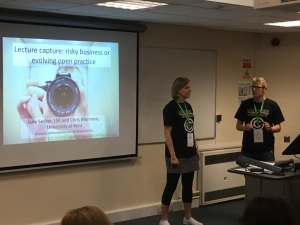 Lecture Capture: Risky Business or Evolving Open Practice? co-presented with Chris Morrisson, Copyright Licensing and Compliance Officer at the University of Kent.
Lecture Capture: Risky Business or Evolving Open Practice? co-presented with Chris Morrisson, Copyright Licensing and Compliance Officer at the University of Kent.
Jane and Chris presented the findings from a recent survey on institutional attitudes towards intellectual property issues in relation to lecture capture and contents used in lectures. They also reflected on the relation between good policy and good practice and how to support staff in implementing and encouraging it.
Keynote: Copyright and eLearning: Understanding our Privileges and Freedoms
Jane presented an entertaining, fun, moving and very interesting keynote on how a better understanding of copyright can empower copyright users and educators.
You can view Jane’s full keynote on youtube:
Last But Not Least: We won!
LTI was presented with the prestigious Team Learning Technologist of the Year Award last Wednesday for their work around Students as Producers. The award recognises “outstanding achievements in the learning technology field and the promotion of intelligent use of Learning Technology on a national scale”.
“LSE are proud to be selected as the Learning Technology team of the year, especially in its 10th year. This recognition by our peers is a celebration of the innovative work being done by academic and LTI staff to better the student experience and provide more opportunities for engaging, positive and transformational education with technology.” Peter Bryant, Head of LTI
Here are a few pictures from the evening:


